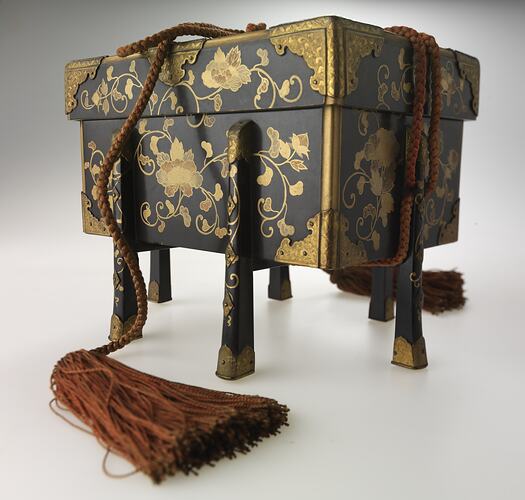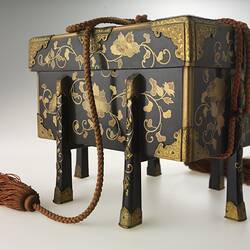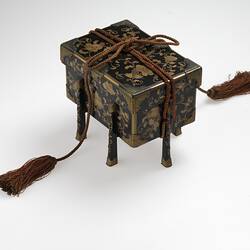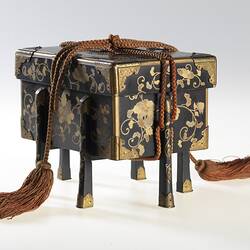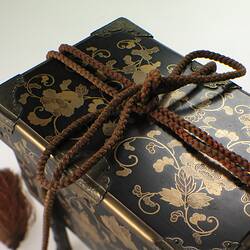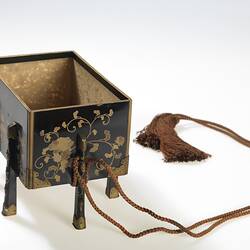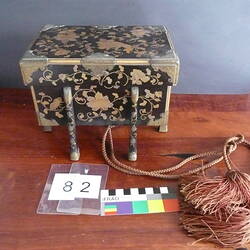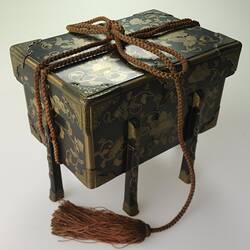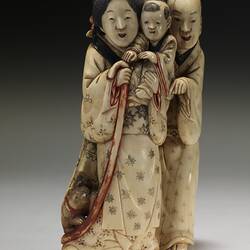Summary
Miniature wooden maki-e lacquered Ko-Karabitsu with peony scroll design, manufactured in Japan during the late Edo - early Meiji period (1850-1880).
A Karabitsu is traditionally a six-legged Chinese-style chest, used for the storage of samurai armour. The term derives from the Japanese word 'Kara', meaning 'China', and 'Ko', the Japanese word for 'small'. Because of its size, this Ko-Karabitsu was probably used to store personal items or cosmetics.
Maki-e lacquering is a Japanese technique of sprinkling fine gold or silver powder into a design laid out in lacquer, using small brushes or bamboo tubes to create fine, often highly detailed and intricate designs. Other metals could be employed to achieve different colours, such as brass, copper, plantinum, pewter, as well as other alloys. The technique was first developed during the Heian period (794-1185) and flourished as a decorative style during the Edo period (1600-1868).
The beautiful decorative work of maki-e lacquer ware, combined with the increasing interest in the West of things Japanese, made such items as this incredibly popular for export markets. One advertisement, appearing in Melbourne's Argus newpaper in December 1880 some months after the International Exhibition had opened, promoted the sale of Japanese art exhibits 'just arrived from Japan. Collected specially by a gentleman resident in Japan for 14 years, for the Melbourne International Exhibition, but shut out in consequence of arriving too late for admission.' The advertisement continued by noting the 'very beautiful assortment of porcelain and lacquer ware, arranged in lots specially suitable for Christmas presents'.
Physical Description
Six legged lacquered, rectangular box with lid slightly larger than the box. Decorated all over with peony scroll design. A red/brown silk tassel (the colour has faded over time and would have originally been of imperial red) is tied underneath the side legs and under the body of the chest.
More Information
-
Collection Names
-
Collecting Areas
-
Acquisition Information
Cultural Gifts Donation from Dr Will Twycross, 23 Jan 2009
-
Acknowledgement
Donated through the Australian Government's Cultural Gifts Program
-
Place & Date Made
-
Place & Date Exhibited
Royal Exhibition Building (REB), Melbourne, Greater Melbourne, Victoria, Australia, 1880-1881
-
Collector
Mr John Twycross, Elsternwick, Greater Melbourne, Victoria, Australia, 1880
-
Inscriptions
Evidence of a paper label on underside of chest visible.
-
Classification
Royal exhibition building, International exhibitions, Exhibition heritage
-
Category
-
Discipline
-
Type of item
-
Overall Dimensions
195 mm (Width), 135 mm (Depth), 155 mm (Height)
-
Dimensions
215 mm (Length), 153 mm (Width), 160 mm (Height)
Measurement From Conservation. Measurement is of box and does not include tie.
-
References
Argus, Friday, 3 December 1880, p.2
-
Keywords
Exhibitions: Melbourne International, 1880-1881, Japanese Art, Lacquerware, Royal Exhibition Building, Royal Exhibition Building: History of Events, 1879-1899
